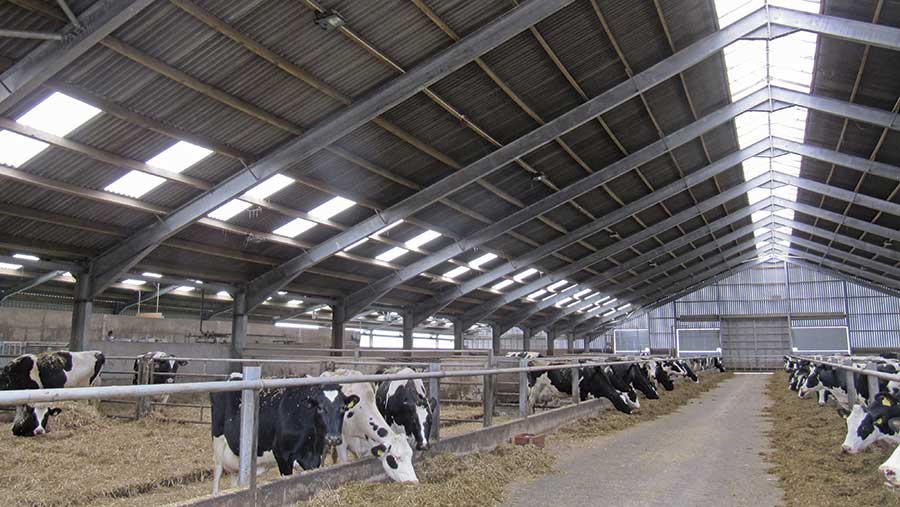Building for better herd health: Designing shed roofs
 © Jamie Robertson
© Jamie Robertson Livestock buildings represent one of the largest investments on farm and one that will pay back and support the business for a long time.
Yet, so many buildings in the UK underperform, with farmers often looking to cut costs instead of viewing the value that can be gained by building better sheds.
Read more on livestock housing
The roof has three primary requirements:
- To keep rain out
- Provide shelter
- Provide shade (if animals are housed year-round)
Roof design is the number one reason too many livestock buildings are not fit for purpose.
The reason for the failure is a building fails to “breathe”.
Breathing is key because of the substantial amount of heat and moisture created by livestock on a daily basis, within that building.
The wind may provide ventilation to remove moisture, but where wind-driven ventilation is restricted by other adjacent structures, or when the wind doesn’t blow, it becomes essential the roof can breathe.
Below are three essentials for the roof design.
1. Roof slope
The roof slope is a critical feature and has a lifelong performance impact.
The steeper the slope, the better a building can ventilate, but it has a higher material cost than a flatter roof.
And the planners often do not wish to accept building with a high ridge height, so the whole decision-making process leans towards low-pitch roofs that intrinsically, and for the rest of the life of the building, perform poorer for the livestock within it.
Targets
- A standard roof slope is 15deg. Below this pitch airflow is reduced at zero or low wind speeds.
- A slope of 22deg is better and has an ideal airflow, while 12.5deg worse.
- If the building is larger than 9m in width a pitched roof is required.
2. Roof openings
All livestock buildings need holes in the roof to allow heat and moisture to escape, otherwise, heat and moisture must accumulate.
The objective calculation of roof openings was understood and published many years ago and is now freely available to farmers.
This information has been widely ignored for 30 years with even the recent application of CE building standards to the best of UK buildings manufacturers failing to address the fact buildings should be assessed as to their capacity to competently house the livestock within them.
A correctly designed open ridge will also keep all the rain out.
The requirement is for an area of opening in the roof suitable for the livestock inside.
A useful ballpark figure for assessing buildings is a roof outlet requirement for 0.1sq m per adult cattle at ridge height.
For example, 100 cows would require (ballpark only) a 10sq m opening in the ridge. This approximation is refined by the slope of the roof and by the stocking density (the energy density) under the roof.
And, so arrives the first of the cost versus value arguments.
If the building is 30m (100ft) long, a cap on the whole ridge might cost £20/m, a cranked ridge crown £30/m, a competent open ridge £50/m and a covered open lightridge just over £100/m.
The difference in material cost for a complete ridge is £600 to £3,000, but the more expensive ridge will pay back in two to three years through 3-5% improvements in liveweight gain and in many cases, reduced chronic health loses.
Thereafter, it will make the business more money for the life of the building. So, ask yourself, which is actually the cheapest ridge?
Targets
- 0.1sq m per adult cattle at ridge height (ballpark figure only)
3. Roof material
The same cost versus value argument arises with the choice of roof material.
Tin is lower cost than cement fibre to purchase, but has a higher running cost, especially if coupled with poor ventilation design.
Tin will increase the stress on youngstock because a tin roof can exaggerate the natural daily variation in temperature, compared to a mineral fibre roof.
Calves in particular are effected by temperature variation, and more stress can equate to more disease, more losses, more expense.
Targets
- The best materials to use are fibre cement corrugated sheets
Remember, buildings are with us a long time so think about their value when deciding on how to design and build them rather than their cost.
Future articles
In the upcoming articles, we will be assessing walls and floors.
For more information on housing design visit AHDB’s advice for better cattle housing design (PDF) or request a copy of their dairy housing best-practice guide.
